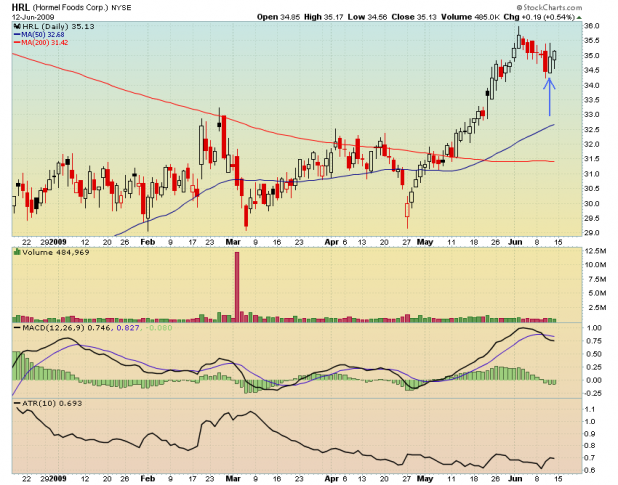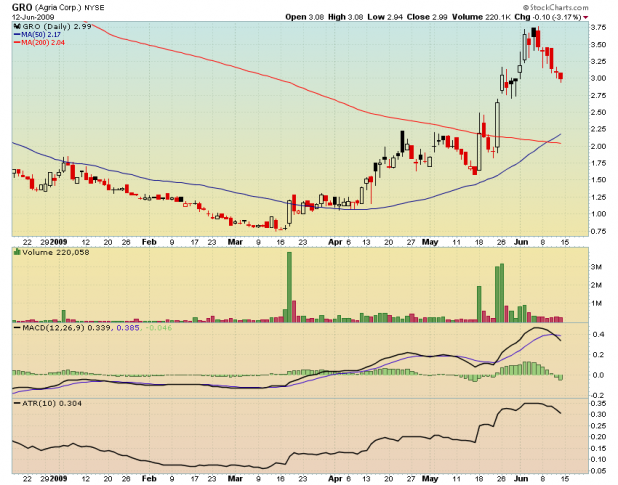HRL was sold on the open. The arrow in the chart above shows the date of purchase.
Selling HRL leaves one space available in the portfolio.
GRO was purchased on the open to fill the available spot.
The Power Dip portfolio is long [[AEO]], [[CAKE]], [[CNK]], [[GRO]], [[EQIX]], [[NKTR]], [[PII]], and [[VRX]].
There are more signals than can be taken by the system. These will be posted in the PPT for our distinguished gentlemen and gentlewomen.





I am of the mind that other than good marketing material, backtesting is not nearly as accurate as they purveyors of this software want you to believe.
I have developed? scores of strategies that have tested profitably, coded for backtesting and for “reality” trading, i.e., with a lookback period. Although these two mirror each other rather closely, the actual trading doesn’t.
I am using AMTD strategy desk and although my numerous conversations with support have developed strategies that”supposed” to emulate actual trading. They don’t!
I realize that actual is based on tick data and that may be a significant reason for a disparity but there is no resemblance at all.
THOUGHTS????
Joseph, I’ve never used AMTD strategy desk.
There is a lot more that goes into successful system development than just backtesting. Backtesting is really just maybe 1/2 of the development process. The other 1/2 has to do with money management and risk control.
Also, there are many many errors that can be made in backtesting that will create a system that will never be profitable in real life.
I would start with using a generous per share allotment of something near .015 to account for slippage and commissions. Using that figure will usually take many profitable strategies and show them to not work in real life.
I have not worked with tick data very extensively. You might have to set your software to look for more than 1 tick before considering an order filled. In real life there may not be enough liquidity to fill your orders.
That is all I can think of right now. Hit me up with more specific issues if you uncover any.
1. data errors in all backtesters
2. different trading dates/times (data may not be updated in time for a trade to match backtest, so you are always trailing the backtest results; backtests may assume Friday close when you don’t get the data until Sat. and can’t trade until Monday)
3. spreads/commissions
4. hidden crystal ball effect or over-fitting of criteria
5. liquidity issues: backtest results may not be as good with stocks priced>$5 and volume>100,000/day
6. variability in start dates: backtester may not try all possible start dates and average them
7. randomness, noise, black-swan events, one-off bad news on the stock you own
Thomas, those are all good points.
Often a great set of returns is generated from just a few very very profitable trades. Get rid of the outliers for more real-life returns.
The start date is also crucial. Many times people who are trying to sell systems start the testing on the day most beneficial to the system.
nice going with the power dips. how do you like TSL here?
Sky, TSL looks juicy, but it didn’t make the power dip criteria. Still, great looking pullback.
Thomas,
Limiting the number of parameters applied to the stocks to a bare minimum can avoid the curve fitting concern. It is not that hard to develop a market-beating system using only three or four degrees of freedom. Sometimes two is all you need.
As for one-off events, that is where risk management and position sizing come into play. One bad trade will never derail a robust trading system if it is implemented with proper risk management.
TY all I realize that backtesting is but one component of one’s trading plan but I am questioning the very viability of backtesting credibility.
Due to the fact that the preponderance of the majority of opinion at a point in time is a major variable, if one can define the psychology of the market players, it may provide a minute edge.
Obviously in order to attempt to create an edge, trader’s try to create various indicators that they believe will somehow divine the next move by those motivated players willing to risk their capital.
Traders are always using indicators which are all lagging, begging to eliminate most of the latency.
Because human behavior is such an integrl part of trading I wonder if auto-trading can ever be consistently profitable.
Joseph, let me give you an analogy.
It has not rained in 3 days. What are the chances there will be a flood on the 4th day? Maybe 3/100? 3% chance? Of course, a chance thundershower could suddenly appear, and there is our 3%.
Now, it has been raining for the past 3 days, and it looks like the rain will continue. Now what is our chance for a flood? 50%? 60%?
The point is that backtesting simply says that the conditions are right for an edge to be present. Not that there will be an edge (flood) but there is x% chance that an edge will exist.
Just cause it rains for 3 days doesn’t mean there will be a flood, but there is a much greater chance for there to be a flood after it has rained for 3 days.
We could take it a step further and decided whether we are preparing for a flash flood (short term setup) or a more extended type of wash that could last for days (a trend setup).
When you say that traders are trying to “divine the next move” what you are really saying is that traders are saying, hey, it has rained for 3 days. It might flood. I think I’ll prepare for it in case it does flood. It is no different from the hardware store owner going out and buying a bunch of raincoats and umbrellas and sandbags. If he is right, he makes money. If not, he loses. But he wouldn’t buy raincoats and such if it hadn’t rained and there was no forecast of rain.
I’m not sure what auto-trading has to do with backtesting except that it just makes it even harder to execute properly as then you have coding, software, and platform issues to contend with.
not speaking to any points here, just dropping my 2¢ in, but ALL backtesting is flawed because of survivorship bias.
At least my software, which is pretty good, does NOT in any way keep track of delisted securities. If your guys’ do, then fantastic, but I don’t believe any of the ones made available to retail traders take this into account.
Danny, I will have all delisted securities going back to 1985, within a couple of months.
Survivorship bias can and should be a real concern if one is testing a system that buys low P/E stocks, or playing penny stocks, as many of those will disappear.
However, the Power Dip is seeking to buy pullbacks in strong stocks with an average hold time of 5 days. As such, I’m not that concerned about survivorship bias. However, I do agree, and that is why I will be picking up the delisted data base.
that is pretty awesome.
and yeah, uncovering an edge, like say, RSI(2) there is def enough sample size, even with the bias, to make a case for why that has an exploitable edge.
I just wanted to throw that out, since it wasn’t mentioned.
Basically, and now off topic from what I said before, I think it is difficult to not curve-fit a strategy (even if accidentally). I think people (I know I did this) frequently make a strategy, see it has a PF of 2, and then say, well what about this number, oh, thats a PF of 2.2 with less drawdown, so it’s a better strategy. That IS curve-ftting.
However, I’m all for incorporating the discovered edge into a trading decision, even if not 100% mechanically.
I leave this stuff to the people that know how to avoid those pitfalls, like my man uncle shed here.
For proof that backtesting can work for the patient, here is an example:
40% Tbills, 60% the top 20 price change in last 26 weeks of the Valueline Ranked #1 stocks, from 1969 to 2008, averaged over all start months, held monthly, assumes $3/trade commissions and .1% spread:
13% compound annual growth rate when the S&P’s was 9%, standard deviation 18 (same as the S&P), sharpe ratio of. 48 (S&P was .27)
http://www.backtest.org/6909c3s.1BLtb11p40rs120p60 (click on run then allmonths)
Screen S&P
1969 -8 -6
1970 -5 2
1971 17 16
1972 1 19
1973 -15 -16
1974 -11 -24
1975 7 36
1976 15 18
1977 6 -10
1978 11 15
1979 34 14
1980 35 36
1981 0 -8
1982 39 30
1983 28 20
1984 -1 2
1985 25 34
1986 16 24
1987 2 6
1988 10 10
1989 24 35
1990 -3 -5
1991 55 31
1992 11 7
1993 29 10
1994 8 2
1995 18 39
1996 36 23
1997 5 28
1998 46 35
1999 101 18
2000 11 -11
2001 4 -9
2002 -5 -22
2003 28 28
2004 6 10
2005 12 8
2006 6 14
2007 22 6
2008 -26 -39
2009 -2 7